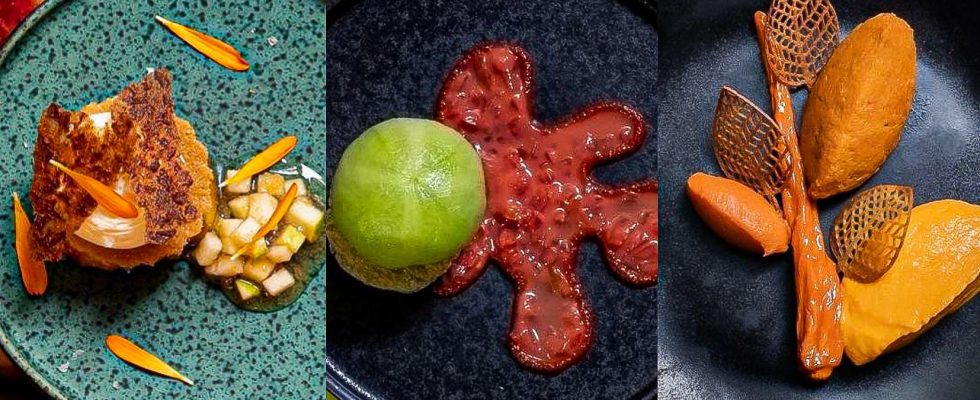Comedians, entrepreneurs, conductors, roofers or even influencers, they are active in the fight against climate change. For L’Express, students from the Institut Pratique du journalisme Paris Dauphine set out to meet small and large players in climate action in France.
“If I come to eat here, it’s because it’s good, accessible and committed.” Sunglasses on his nose, installed on the terrace, Paul is a regular at the restaurant blackberry in Paris. In front of him, the empty plate shows that he enjoyed himself, once again. Before, he used to eat in the brasserie across the street, but he easily changed his habits when this restaurant opened its doors.
Behind the stoves of this establishment like no other, Arnaud Dalibot uses only seasonal products grown less than 30 km from Paris. It participates in the Too Good To Go anti-waste initiative and offers a reduction if the customer brings his deposit to eat to go.
Entirely vegetable but with taste
Like other restaurants, Mûre is followed by Food Index For Good (FIG). This company supports chefs and restaurateurs in the ecological transition. The label is FiG is even awarded to the most virtuous. This is the case of Colette’s TableDirected by Josselin Marie, head of profession who practiced with Joël Robuchon and Alain Ducasse. “I had this state of mind to be eco-responsible. That’s where the idea for my restaurant came from,” he confides. “We worked to calculate the carbon weight of our card.” But when he starts, it’s a slap: “I realized that cooking focused on meat and fish had a very, very high carbon weight”. So he decides to radically change his approach.
A long-term job begins. “To bring out a dish, we made up to 50 cooking, sauce and garnish trials so that it was entirely vegetable but with taste”, says the Breton chef. In many recipes of French cuisine, the taste is provided by the meat, the fish or the juices that are extracted from it. Keeping so many animal products on his menu was not an option for Josselin.
The carbon footprint of its menus varies between less than 1 kilo and 2.8 kilos of CO2 for entirely plant-based menus. A figure divided by 10 compared to its previous card. For a restaurant, 80% of the carbon footprint is concentrated on the plate, 10% goes into energy and the rest corresponds to waste and the transport of teams and goods. “We realized that if you don’t touch the contents of the plate, you don’t touch anything in a restaurant.” To compare, a veal chop from a local farm is 35 kilos of CO2 released when for 1 kilo of carrots that comes from the other side of the world it is 1 kilo of CO2 “. According to him, revegetation is “indispensable”.
Conquered customers
Just because you can eat tomatoes all year round doesn’t mean they don’t have their seasonality too. If it is possible, it is thanks to the culture under heated greenhouse. The fruits produced do not see the light of day and grow continuously. However, this production technique has a heavy impact on the carbon footprint. And for chef Josselin Marie, “if we also talk a lot about seasonality, transport also has an impact even if it remains much weaker than the greening of the plate”.
Consuming locally is one of the criteria that is attracting more and more customers, like Morgane. Sitting on the terrace of the Mûre restaurant, which has made this choice her trademark, the 30-year-old displays a convinced smile, “I always come here even if I’m not a vegetarian, it’s the local side that I like. I know that these are good foods”. On his plate, no more crumbs.
Even with meatless menus, Morgane is conquered by this concept that she does not find everywhere: “It is quite rare to find restaurants like this one so I am happy that it is next to my work. This said, I won’t go so far as to come on purpose to have lunch in this kind of concept”. Blame the clichés on vegetarian dishes that still have a hard tooth.
Not just seeds
“No, an eco-friendly restaurant doesn’t necessarily only offer seeds,” laughs Eva Genel. She is the co-founder of FIG. “Being eco-responsible is a path, there is no perfect restaurant,” she specifies. His company helps establishments like that of Josselin Marie to begin this journey towards ecological commitment. But she assures him, “on the map, establishments can make great progress in reducing their carbon footprint, without becoming the stereotype of the boho vegan”.
Without switching to a 100% vegetarian menu, The 7 Restaurant, located in Bordeaux, has also embarked on its ecological transition alongside FIG. At the beginning of the year, they received the results of their first carbon assessment. “It was incredible, we didn’t expect it to be so strong”, is surprised Camille Lacoste-Massia, communication manager of the establishment. On their menu, mainly meat, so they rebalanced, “in terms of the proportion in the recipes to start”. But there was never any question of completely removing: “We come to the restaurant to have fun. People want to have a good time so we have chosen to keep the dishes with meat.” But not all, as Camille Lacoste-Massia points out, “only low-carbon products such as poultry from the South West”.
This trend towards greening is gaining more and more restaurants. On the terraces, in the dining room or even to take away, customers are also actors in this ecological transition. Camille has seen it well, “Customers are looking for a way to eat that is more respectful of the environment.” And even adds. “If we don’t offer one or two vegetarian options, we’re missing out on some customers.”
